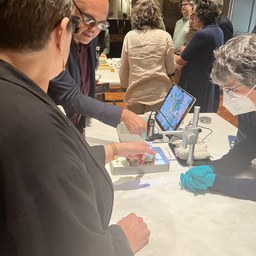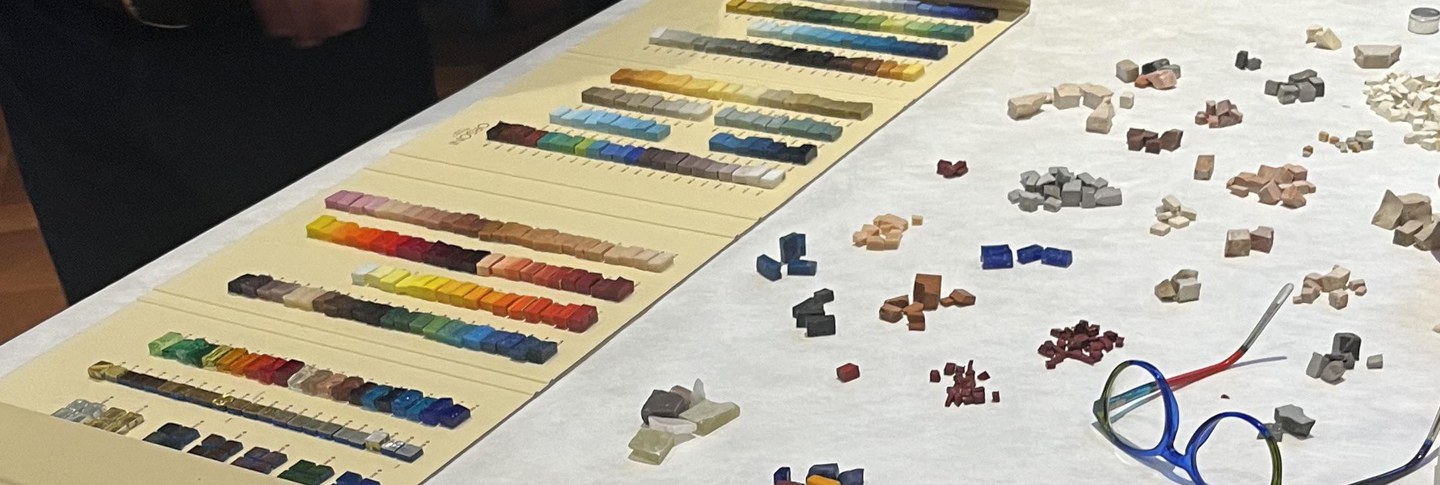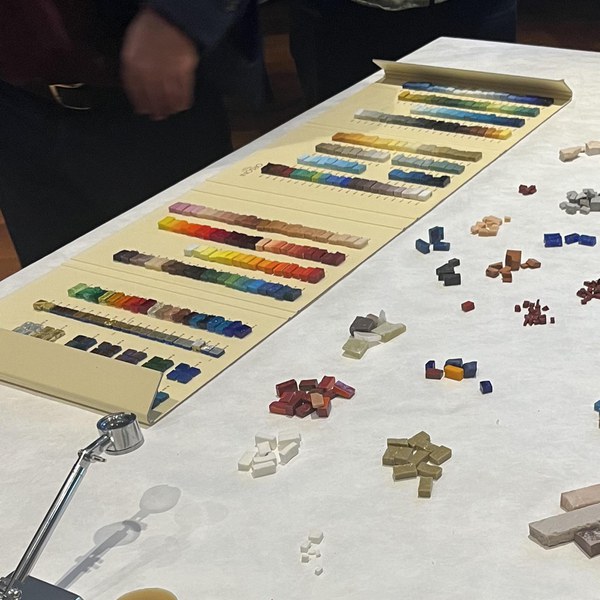 The Dumbarton Oaks Museum colloquium Piece by Piece: Mosaic Artifacts in Byzantium and the Ancient Americas (May 18–19, 2023) posed the question: What happens when you view, side by side, artifacts of the same medium from vastly different cultural contexts? A rare scholarly event organized by the museum department, the colloquium—co-organized by Elizabeth Dospěl Williams (Curator, Byzantine Collection, Dumbarton Oaks), Ivan Drpić (Associate Professor, History of Art, University of Pennsylvania), and John Lansdowne (Post-Doctoral Fellow and Assistant to the Director, Villa I Tatti)—combined scholarly talks with object study sessions. By drawing on the museum’s two Byzantine micromosaic icons (BZ.1947.24, BZ.1954.2), Maya mosaic mask (PC.B.557), and Wari inlaid objects (PC.B.432, PC.B.437), the organizers hoped to generate comparative methodological frameworks for the study of artifacts from the vast global medieval world. Incorporating archaeological, art-historical, and scientific perspectives, speakers and attendees journeyed through time in this exploration of mosaic artifacts.
The Dumbarton Oaks Museum colloquium Piece by Piece: Mosaic Artifacts in Byzantium and the Ancient Americas (May 18–19, 2023) posed the question: What happens when you view, side by side, artifacts of the same medium from vastly different cultural contexts? A rare scholarly event organized by the museum department, the colloquium—co-organized by Elizabeth Dospěl Williams (Curator, Byzantine Collection, Dumbarton Oaks), Ivan Drpić (Associate Professor, History of Art, University of Pennsylvania), and John Lansdowne (Post-Doctoral Fellow and Assistant to the Director, Villa I Tatti)—combined scholarly talks with object study sessions. By drawing on the museum’s two Byzantine micromosaic icons (BZ.1947.24, BZ.1954.2), Maya mosaic mask (PC.B.557), and Wari inlaid objects (PC.B.432, PC.B.437), the organizers hoped to generate comparative methodological frameworks for the study of artifacts from the vast global medieval world. Incorporating archaeological, art-historical, and scientific perspectives, speakers and attendees journeyed through time in this exploration of mosaic artifacts.
The first day of the colloquium considered mosaics across cultural contexts to offer different frameworks for understanding the art, as well as to analyze the impact of collecting on art-historical understanding of the medium. Speakers also considered the significance mosaic objects held in their original contexts, as both artistic wonders and as objects of political and spiritual significance. The second day of the colloquium delved into the corpus of Byzantine micromosaic icons, exploring production techniques, materials, and scientific analysis, and examining past conservation efforts.
 Colloquium speakers and workshop attendees heard from conservators about exciting recent studies of the two micromosaic icons in the Dumbarton Oaks collection. Smithsonian Museum Conservation Institute (MCI) scientists Thomas Lam, Edward Vicenzi, and Keats Webb; National Museum of the American Indian conservators Stephanie Guidera and Emily Kaplan; and University of West Attica Professors Stefania Chlouveraki and Dimitrios C. Makris, shared data regarding material makeup of the icons and evidence of the tools and techniques artisans used. The data are the result of more than two weeks of extensive imaging at MCI, including 2D and 3D imaging techniques, portable X-ray florescence spectrometry, and scanning electron microscopy. Workshop attendees had the opportunity to use a microscope to examine the collection’s Byzantine micromosaics, Wari mosaic mirror, and Maya mosaic mask.
Colloquium speakers and workshop attendees heard from conservators about exciting recent studies of the two micromosaic icons in the Dumbarton Oaks collection. Smithsonian Museum Conservation Institute (MCI) scientists Thomas Lam, Edward Vicenzi, and Keats Webb; National Museum of the American Indian conservators Stephanie Guidera and Emily Kaplan; and University of West Attica Professors Stefania Chlouveraki and Dimitrios C. Makris, shared data regarding material makeup of the icons and evidence of the tools and techniques artisans used. The data are the result of more than two weeks of extensive imaging at MCI, including 2D and 3D imaging techniques, portable X-ray florescence spectrometry, and scanning electron microscopy. Workshop attendees had the opportunity to use a microscope to examine the collection’s Byzantine micromosaics, Wari mosaic mirror, and Maya mosaic mask.
The scientific discussion underscored the trans-temporality of the mosaic objects. As co-organizer Elizabeth Dospěl Williams noted in her closing remarks, to look through a scanning electron-microscope is like time travel, illuminating the work of past conservators and curators, as well as evidence left by viewers of the past. Close study of mosaic objects in both Mesoamerican and Byzantine contexts reveals resonances over and despite boundaries of time and space. At Dumbarton Oaks, where seemingly disconnected objects are placed in neighboring galleries, these resonances are deeply felt.
The full list of speakers and talks can be found here.

